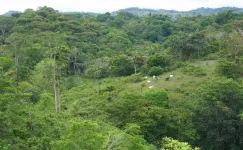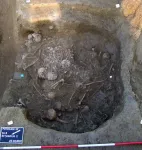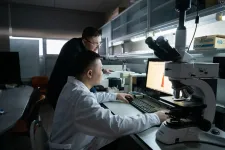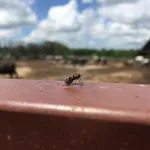(Press-News.org) OSAKA, Japan - The hippocampus is the part of the brain that deals with information associated with spatial navigation and memory. For example, you are driving and despite the changing environment of different cars going at varying speeds, on and off ramps, distracting billboards, etc., you adjust your speed, glance only momentarily at the billboards, and navigate the roads in a smooth and timely manner. This is your hippocampus at work. It takes the input - a continuously changing environment - and helps turn it into the output - using memory of a road map to safely navigate your way. However, little is known about how information is distributed from the hippocampus to other brain regions that results in the output behaviour.
A research team led by Lecturer Takuma Kitanishi and Professor Kenji Mizuseki of the Department of Physiology, OCU Graduate School of Medicine have clarified for the first time that spatial information received from the hippocampus is further directed downstream by a region of the brain called the subiculum.
"The hippocampus processes information we are all familiar with in our daily life - from our commute to work to going to see grandma", says Kitanishi, "however, commonly used methods of measuring brain activity have not allowed us to know to which brain region the hippocampus transmits information."
The team devised a method to track this inter-regional flow of neuronal activity. Combining large-scale neuronal activity recording and multi-site optical stimulation, they measured the brain activity of free-moving rats. What they found was that while the hippocampus received and transmitted a wide range of information, the subiculum routed the information inherited from the hippocampus in a noise-resistant manner. Think of the subiculum as the sorting office of your local hippocampal postal service.
"We found that information on "speed" and "trajectory" was selectively transmitted to the retrosplenial cortex and nucleus accumbens regions of the brain, respectively, while information on "place" was equally distributed among four regions: the nucleus accumbens, anteroventral thalamus, mammillary body, and retrosplenial cortex", states Kenji Mizueki.
The team also observed that the theta brain waves and sharp-wave/ripples emitted from the subiculum controlled the timing of information transmission depending on which region of the brain the subicular neurons targeted and the timing was precisely managed down to the millisecond. This could help explain the selective nature of the subiculum and why your awareness of the changing environment and continuous updates to your driving all happen at the same time.
The team plans to use their new method of tracking neuronal activity on a wider scale. "Next, we will include hippocampal information generated by peripheral sensory inputs", states Kitanishi. Using this research as a basis for a comprehensive understanding of the hippocampal memory system, "We even hope to shed light on disorders associated with hippocampal malfunction such as dementia."
INFORMATION:
Funding
JST PRESTO (JPMJPR1882), Grants-in-Aid for Scientific Research (20H03356, 19H05225, 18H05137, 17K19462, 16H04656, 16H01279, 20K06878, 19H04937, 17H05977 , 17H05575), Toray Science Foundation, Takeda Science Foundation, Uehara Memorial Foundation for Life Science, Naito Foundation for the Advancement of Science, Nakajima Foundation for International Exchange, Sumitomo Electric Group Social Contribution Fund, Life Science Foundation of Japan, Brain Science Foundation, Shimadzu Science and Technology Foundation, Novartis Science Foundation.
We are Osaka City University - the oldest research university in Osaka. With 9 undergraduate faculties and 11 graduate schools all dedicated to making urban life better, energy cleaner, and people healthier and happier, we have won numerous awards and have produced 2 Nobel laureates. For more information, please visit our website at https://www.osaka-cu.ac.jp/en
Social distancing not only helped slow the spread of COVID-19 -- it also may have prevented the transmission of an outbreak of a rare polio-like syndrome, according to Princeton University researchers.
Though uncommon, acute flaccid myelitis (AFM) is a critical spinal condition that causes weakness in the limbs, seriously diminishes motor function, and can lead to lifelong disabilities. The syndrome was first reported in the United States in 2012 and has been coming back every two years, hinting it could strike again in 2020.
Using epidemiological surveillance tools, the researchers showed that an AFM outbreak was ...
Harnessing a predictive algorithm, Sang Woo Park and colleagues have mapped out new trends in the incidence of the respiratory virus enterovirus D68 in the U.S. since 2014. Their epidemiological study supports research that has linked enterovirus D68 to acute flaccid myelitis (AFM), a rare and mysterious paralyzing disease, and addresses critical gaps in knowledge of how enterovirus D68 has been spreading in the U.S. The analysis also suggests that social distancing interventions during the COVID-19 pandemic likely lowered the prevalence of AFM in 2020. Cases of the polio-like illness AFM, which rapidly results in ...
Adolescents and young adults may be more susceptible to COVID-19 than previously believed, according to analysis of cases in six U.S. states experiencing surges.
INFORMATION:
Article Title: Prevalence of COVID-19 in adolescents and youth compared with older adults in states experiencing surges
Funding: The authors received no specific funding for this work.
Competing Interests: The authors have declared no competing interests exist.
Article URL: https://journals.plos.org/plosone/article?id=10.1371/journal.pone.0242587
...
Individuals' willingness to engage in COVID-19 control measures is associated with their trust in the government, other citizens, and in particular science, according to a new study published this week in the open-access journal PLOS ONE by Stefano Pagliaro of University of Chieti-Pescara, Italy, and colleagues.
The spread of SARS-CoV-2 since December 2019 has posed a severe public health threat to people around the world. As vaccines are being rolled out, behavioral changes are also necessary to counter the spread of the virus. These actions include both prescribed behaviors such as wearing masks, social distancing, and quarantining, as well as discretionary prosocial behaviors like donating to charities ...
New research conducted at the UNESCO World Heritage listed 'Plain of Jars' in Laos has established the stone jars were likely placed in their final resting position from as early as 1240 to 660 BCE.
Sediment samples from beneath stone jars from two of the more than 120 recorded megalithic sites were obtained by a team led Dr Louise Shewan from the University of Melbourne, Associate Professor Dougald O'Reilly from the Australian National University (ANU) and Dr Thonglith Luangkoth from the Lao Department of Heritage.
The samples were analysed using a technique called Optically Stimulated Luminescence (OSL) to determine when sediment grains were ...
A new study, published this week in Proceedings of the National Academy of Sciences, reveals that nitrogen-fixing trees play an underrecognized role in recovering tropical forests by enriching nutrient-poor soils with scarce elements such as phosphorus and molybdenum.
Coauthor Sarah Batterman, a tropical forest ecologist at END ...
In previous research, ancient massacre sites found men who died while pitted in battle or discovered executions of targeted families. At other sites, evidence showed killing of members of a migrant community in conflict with previously established communities, and even murders of those who were part of religious rituals.
But a more recent discovery by a research team -- that includes two University of Wyoming faculty members -- reveals the oldest documented site of an indiscriminate mass killing 6,200 years ago in what is now Potocani, Croatia.
"The DNA, combined with the archaeological and skeletal evidence -- especially that ...
An international research team led by NUST MISIS has developed a new iron-cobalt-nickel nanocomposite with tunable magnetic properties. The nanocomposite could be used to protect money and securities from counterfeiting. The study was published in Nanomaterials.
Presently, research on magnetic nanomaterials with controlled magnetic characteristics is one of the most promising fields. Due to their small size, as well as their excellent magnetic and electric properties these materials have a broad range of potential applications from mobile devices to space technologies.
The new iron-cobalt-nickel nanocomposite was obtained by chemical precipitation, followed by a reduction process.
"This ...
Researchers hope to use an agricultural pest's genetic code against it to prevent billions of dollars in annual losses in the United States.
Stable flies, or Stomoxys calcitrans, are spotted, tan-colored flies found around the world. They are easily mistaken for the common housefly but for one notable distinction: They bite.
"If you get one in your house and it bites you, it's a stable fly," said Joshua Benoit, an assistant professor of biology at the University of Cincinnati.
Stable flies don't bite so much as chomp. They are the scourge of beachgoers in Florida and recreational boaters in upstate New York. According to Thomas Jefferson, they tormented signatories ...
DALLAS - March 10, 2021 - UT Southwestern scientists have identified key genes involved in brain waves that are pivotal for encoding memories. The END ...







